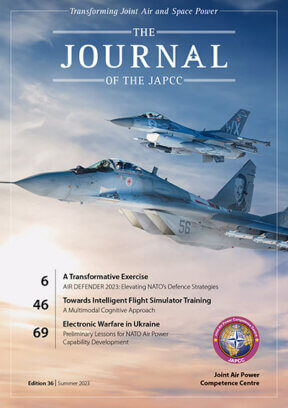Decoding the Objectives of AIR DEFENDER 2023
Initiated by Germany in 2018, AIR DEFENDER 2023 (AD23) aimed to be the most extensive deployment and live flying exercise of Air Forces in Europe since the establishment of NATO. Its purpose was to send a strong message of deterrence to potential aggressors and showcase the unity of the alliance. Moreover, it sought to demonstrate Germany’s capacity to lead an exercise of such scale and, importantly, to test its logistical and support capabilities. Especially this final challenge could be effectively addressed by hosting and integrating a detachment of the US Air National Guard, deploying from the United States to Germany with over 100 aircraft.
A fictional NATO Article 5 scenario was selected to provide a realistic backdrop for the exercise, ensuring that it encompassed the full range of air power: command, control, and execution.
AD23 was a dynamic flying exercise conducted over Germany and neighbouring countries from 12 June to 23 June, 2023. The exercise involved a total of 241 aircraft from 54 different flying units, with personnel representing 25 nations, deployed across 26 airbases. The primary objective was to conduct three Composite Air Operations (COMAOs) per day, along with up to 50 additional Continuation Training missions, resulting in a maximum of 240 planned sorties daily. The Joint Force Air Component Headquarters (DEU) served as the exercise’s Air Command and Control (AirC2) agency, responsible for tasking and monitoring all operations.
Reflecting on the exercise, it is impressive that out of the initially planned 2036 sorties, a remarkable 1808, or 90% of the planned sorties, were successfully executed without any significant impact on flight safety. The few cancellations were primarily due to operational or weather-related factors.
From the perspective of AirC2, what insights were gained from AIR DEFENDER 2023?
Every exercise teaches lessons, and the larger the exercise, the more lessons you can identify. Numerous participants have submitted valuable observations to enhance exercises like AD23, making them even more seamless in the future. I sincerely appreciate your help and extend my thanks! However, today, I would like to focus on three significant observations.
In general, NATO was long overdue for an exercise like AD23. Most exercises typically focus on a single level, such as AirC2 or flying units. While these exercises are necessary for familiarizing oneself with tactics, techniques, and procedures, AD23 took it a step further.
AD23 required the coordination of flying operations from 54 units across 26 Airbases, spanning multiple countries including Germany, Poland, the Czech Republic, Denmark, Romania, and the three Baltic States. This complex task also had to take into account civilian air traffic. To tackle these challenges, a modified JFAC HQ (DEU) (Joint Force Air Component Headquarters) was established to provide centralized AirC2 planning and execution.
The additional integration of specialists from flying units, known as ‘Airbosses’, into the JFAC was crucial in capturing unit-level training requirements and objectives. They also played a key role in developing COMAO vignettes for the exercise. During the execution phase, the Airbosses were instrumental in refining and leading the vignettes.
Despite numerous meetings during exercise preparation, AD23 revealed differing perspectives and perceptions of the AirC2 process. This occasionally led to friction and misunderstandings between the Airbosses and the JFAC, resulting in incomplete information flow. As a result, the reporting process was affected, with minimal reporting taking place at the beginning of the exercise.
It became evident that reporting is essential for a JFAC HQ to effectively execute Command and Control in an operation. However, it was challenging to emphasize the importance of reporting, as subordinate units were no longer accustomed to fulfilling basic reporting requirements to their headquarters. This lack of training in reporting to multinational (NATO) Headquarters from their home stations had become the norm over the past few decades.
The primary focus of the flying portion was on COMAOs, which required detailed mission planning, briefing, debriefing, and reporting. To ensure the security of classified information, various systems, including VTCs (Video Teleconferencing), were utilized. It is crucial to have the capability to communicate and coordinate using a classified IT structure, as it is essential for the NATO alliance to fulfill its primary commitment of defending all partner nations in an Article 5 scenario against a peer enemy.
During this exercise, Germany faced the challenge of relying on two separate classified networks. This was due to the absence of a consolidated system that could connect the headquarters with the individual units and squadrons. The NSWAN (NATO SECRET Wide Area Network) was employed for original AirC2 (Air Command and Control) matters, while an additional national classified system was primarily used for briefing and debriefing purposes. Furthermore, there were connectivity issues with other nations, which Germany managed well by deploying additional manpower. However, it is crucial to address this issue for future exercises and, more importantly, in the event of an actual operation.
Conclusion
In conclusion, the AIR DEFENDER exercise highlighted the importance of several key factors. Firstly, it emphasized the need for a single, reliable, resilient, robust, and interoperable classified IT system. This system should include features such as J-Chat (NATO Chat tool) and VTC capability to facilitate effective communication between higher HQs and the corresponding units.
Additionally, the exercise revealed the necessity for a revision of the Airboss integration and a refinement of the exercise planning organization, particularly in terms of scenario and vignette preparation. These improvements would contribute to a more streamlined and efficient training experience.
Furthermore, the analysis conducted during the exercise shed light on the potential areas for enhancing training in terms of collaboration between the JFAC HQ and unit level. This could involve implementing academic programs prior to the exercise and increasing the involvement of the JFAC HQ in Live Flying Exercises.
To summarize, AD23 provided a unique opportunity for the JFAC HQ (DEU) to engage in tactical level operations with multiple affiliated entities. The diverse range of participating nations, units, and assets created an environment that closely resembled a real air operation. In my opinion, AD23 was an outstanding success. Let us continue to work together in the light of the AD23 slogan ‘Stronger together’.












